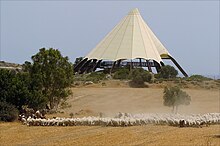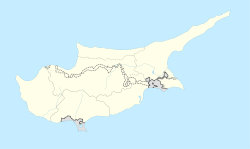(Greek: Tέντα) | |
 View of Tenta (protective structure) | |
| Alternative name | Kalavasos-Tenta or Tenda |
|---|---|
| Location | Larnaca District, Cyprus |
| Coordinates | 34°45′09″N 33°18′11″E / 34.75250°N 33.30306°E |
| Type | Settlement |
| History | |
| Founded | c. 8000 BC |
| Abandoned | before 5000 BC |
| Periods | PPNB |
| Cultures | Cypriote Aceramic Neolithic |
| Site notes | |
| Discovered | 1940 |
| Excavation dates | 1947–1984 |
| Archaeologists | Porphyrios Dikaios |
| Management | Cyprus Department of Antiquities |
| Public access | yes |
Tenta, also referred to as Kalavasos-Tenta or Tenda, is an Aceramic Neolithic settlement located in modern Kalavasos near the southern coast of Cyprus.[1] The settlement is approximately 38 kilometres southwest of Larnaca and approximately 45 kilometres south of Nicosia.[1][2] Tenta occupies a small natural hill on the west side of the Vasilikos valley, close to the Nicosia–Limassol highway.[3]
The earliest occupation at the site has been dated to around 8000 BC, which is contemporary with the sites Shillourokambos and Mylouthkia,[4] and notably predating Khirokitia by almost a millennium.[3] It was still settled during the 6th millennium BC,[5] but deserted at some point before the advent of the Cypriotic Ceramic Neolithic.[1]
Six seasons of excavation in Tenta occurred from 1947 to 1984.[3][6] The obtained data is of interest to studies of cultural change in Prehistoric Cyprus because Tenta's architectural remains, artefacts, human burials, flora and fauna have been "virtually unchanged for two millennia, suggesting that there was considerable continuity in social organisation as well as technological and economic practices."[3]
Today, the site is open to visitors (with entrance fee), and protected by a characteristic, modern cone-shaped roof.[7] The roof is considered a local landmark,[8] and the site a popular tourist attraction.[9]
- ^ a b c "Department of Antiquities - Archaeological Sites". Ministry of Transport, Communications and Works. Retrieved 2022-05-09.
- ^ Todd, Ian A. (1978). "Excavations at Kalavasos-Tenta, Cyprus". Archaeology. 31 (4): 58–59. ISSN 0003-8113. JSTOR 41726235.
- ^ a b c d Clarke, Joanne (2006-09-01). "New volumes on the Vasilikos Valley in Cyprus". Antiquity. 80 (309): 727–730. doi:10.1017/S0003598X00094217. ISSN 0003-598X. S2CID 231656804.
- ^ Moutsiou, Theodora (4 February 2019). "The Obsidian Evidence for Trans-maritime Interactions in the Eastern Mediterranean: The View from Aceramic Neolithic Cyprus". Journal of Mediterranean Archaeology. 31 (2): 229–248. doi:10.1558/jma.38084. S2CID 165999521.
- ^ Gomez, Basil; Glascock, M. D.; Blackman, M. J.; Todd, I. A.; Kres, Leah A.; Lovell, Nancy C. (1995). "News and Short Contributions: Neutron Activation Analysis of Obsidian From Kalavasos-Tenta". Journal of Field Archaeology. 22 (4): 503–515. doi:10.2307/530200. ISSN 0093-4690. JSTOR 530200.
- ^ "Καλαβασός / Kalavasos - Tenta". www.kalavasos.org. Community Council of Kalavasos. Retrieved 20 July 2022.
- ^ "Kalavasos – Tenta Archaeological Site". VisitCyprus. Deputy Ministry of Tourism. Retrieved 21 July 2022.
- ^ Schmid, Martin (April 1998). "Protective shelters at the archaeological sites of Mallia (Crete) and Kalavasos-Tenta (Cyprus)". Conservation and Management of Archaeological Sites. 2 (3): 143–153. doi:10.1179/cma.1998.2.3.143. ISSN 1350-5033.
- ^ Knapp, A. Bernard (2002). "Review of The Earliest Prehistory of Cyprus: From Colonization to Exploitation". Bulletin of the American Schools of Oriental Research (328): 81–84. doi:10.2307/1357781. ISSN 0003-097X. JSTOR 1357781.
© MMXXIII Rich X Search. We shall prevail. All rights reserved. Rich X Search

